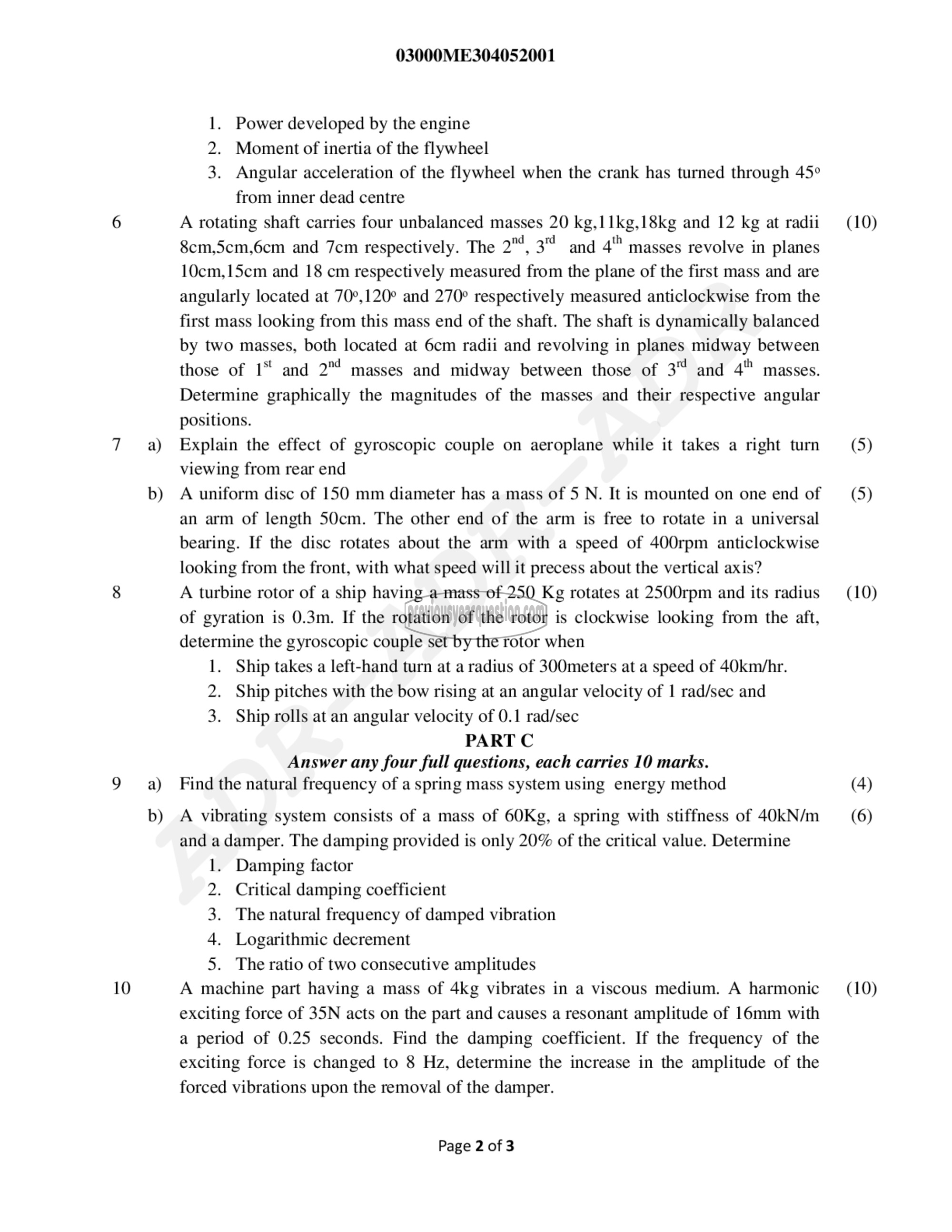APJ ABDUL KALAM TECHNOLOGICAL UNIVERSITY Previous Years Question Paper & Answer
Semester : SEMESTER 6
Subject : Dynamics of Machinery
Year : 2020
Term : SEPTEMBER
Branch : MECHANICAL ENGINEERING
Scheme : 2015 Full Time
Course Code : ME 304
Page:2
6
7 2)
b)
8
9 a)
b)
10
03000ME304052001
1. Power developed by the engine
2. Moment of inertia of the flywheel
3. Angular acceleration of the flywheel when the crank has turned through 45°
from inner dead centre
A rotating shaft carries four unbalanced masses 20 kg,1 1kg,18kg and 12 kg at radii
8cm,5cm,6cm and 7cm respectively. The 20 ٦ and ہے masses revolve in planes
10cm,15cm and 18 cm respectively measured from the plane of the first mass and are
angularly located at 70°,120° and 270° respectively measured anticlockwise from the
first mass looking from this mass end of the shaft. The shaft is dynamically balanced
by two masses, both located at 6cm radii and revolving in planes midway between
those of 1‘ and 2™ masses and midway between those of 37 and 4" masses.
Determine graphically the magnitudes of the masses and their respective angular
positions.
Explain the effect of gyroscopic couple on aeroplane while it takes a right turn
viewing from rear end
A uniform disc of 150 mm diameter has a mass of 5 N. It is mounted on one end of
an arm of length 50cm. The other end of the arm is free to rotate in a universal
bearing. If the disc rotates about the arm with a speed of 400rpm anticlockwise
looking from the front, with what speed will it precess about the vertical axis?
A turbine rotor of a ship having a mass of 250 Kg rotates at 2500rpm and its radius
of gyration is 0.3m. If the rotation of the rotor is clockwise looking from the aft,
determine the gyroscopic couple set by the rotor when
1. Ship takes a left-hand turn at a radius of 300meters at a speed of 40kni/hr.
2. Ship pitches with the bow rising at an angular velocity of 1 rad/sec and
3. Ship rolls at an angular velocity of 0.1 rad/sec
PART C
Answer any four full questions, each carries 10 marks.
Find the natural frequency of a spring mass system using energy method
A vibrating system consists of a mass of 60Kg, a spring with stiffness of 40kN/m
and a damper. The damping provided is only 20% of the critical value. Determine
1. Damping factor
2. Critical damping coefficient
3. The natural frequency of damped vibration
4. Logarithmic decrement
5. The ratio of two consecutive amplitudes
A machine part having a mass of 4kg vibrates in a viscous medium. A harmonic
exciting force of 35N acts on the part and causes a resonant amplitude of 16mm with
a period of 0.25 seconds. Find the damping coefficient. If the frequency of the
exciting force is changed to 8 Hz, determine the increase in the amplitude of the
forced vibrations upon the removal of the damper.
Page 2 of 3
(10)
(5)
(5)
(10)
(4)
(6)
(10)
